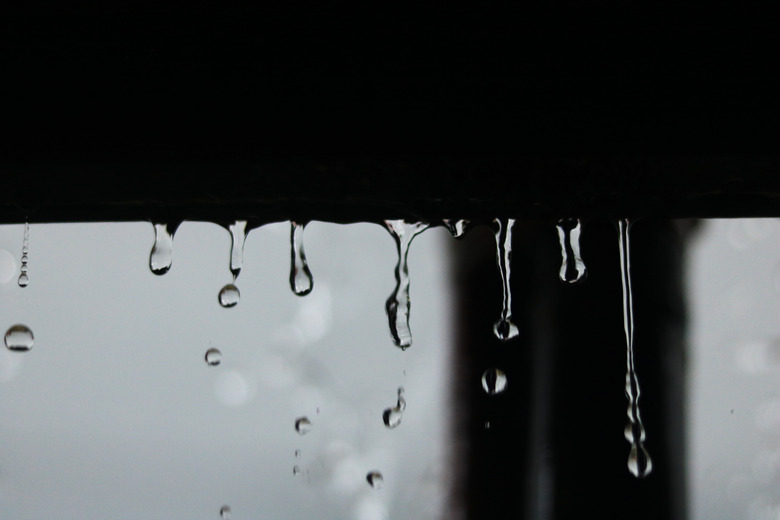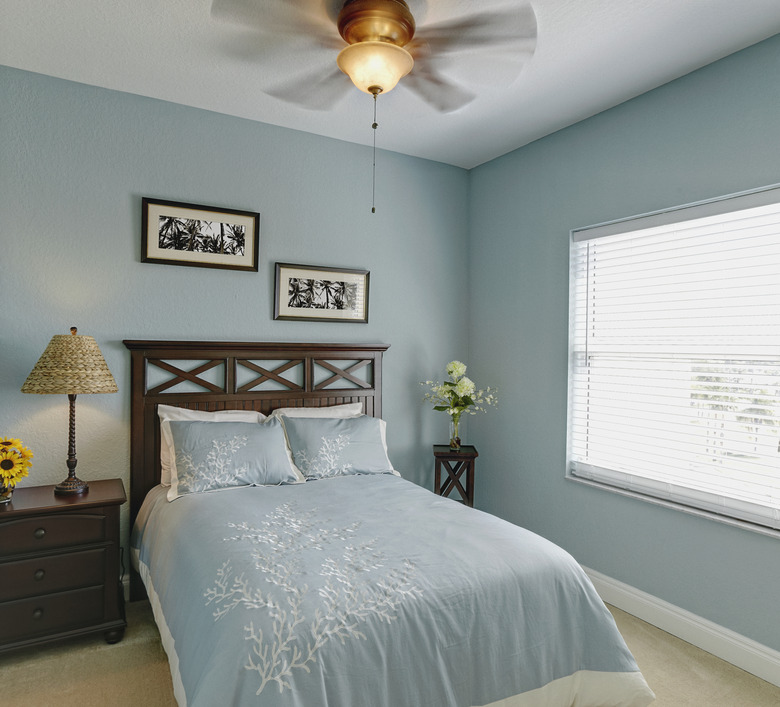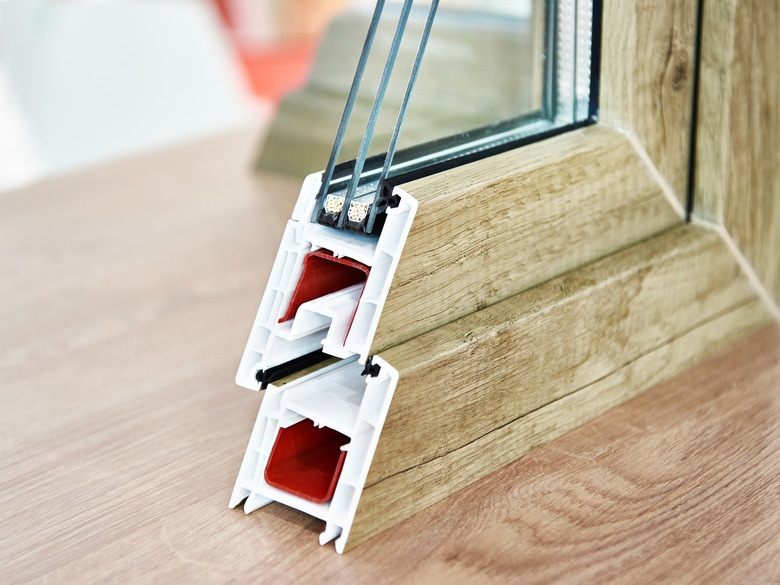How To Stop Condensation On Windows
You may not care as much about what causes condensation on your windows as you do about how to control it, but it's easier to control something if you understand it, and condensation is easy to understand. To put it as simply as possible, condensation is basically rain. As you probably know, rain occurs when a mass of warm, humid air meets a mass of cold air. Because cold air holds less moisture than warm air, the humidity in the warm air condenses into water droplets as the air cools.
Why does this happen on your windows? It's because glass is a relatively poor thermal insulator, so in winter, it radiates heat to the outside. In the summer, when you're running your air conditioner, the glass radiates warm air from outside into your house, inward. The cooler glass causes moisture in the warmer humid are to condense on its surface. That's all the humidity in the air needs to condense into water droplets. It's like a mini weather system on your windows.
Insulated windows consist of two panes of glass separated by a small gap filled with an inert gas, such as argon. They are designed to reduce thermal transmission, but occasionally, you might find condensation forming between the panes. This is a different problem than surface condensation, and it's harder to deal with.
Tip #1: Reduce the Humidity
Tip #1: Reduce the Humidity
If you can reduce moisture in the air, there will be less water to precipitate onto the windows. You can't do much about humidity in the air outside, but there are several ways you can reduce humidity indoors.
- Move plants away from the windows. Plants transpire humidity into the air, so if you notice condensation behind your favorite fern, consider moving it to another part of the room. Hopefully you can find a sunny spot for it under a skylight or against a sunny wall opposite the window.
- Run a dehumidifier. A dehumidifier can significantly reduce humidity in a room with a condensation problem. If you're running a humidifier because the air is too dry, turn it down.
- Check your gas system. Water vapor is a byproduct of propane and natural gas combustion. It should be safely vented outside, but if the system has a leak, the venting may be incomplete, and the humidity in your house may be too high. Warning: If you notice that windows are developing a lot of condensation when your furnace or oven is running, it may indicate some rather serious venting problems and possible carbon monixide (CO) issues. Have a technician check things out if this occurs frequently.
- Use a desiccant . You can buy passive moisture absorbers at most hardware stores. These consist of containers filled with silica gel. Place one or two of these under problem windows to reduce humidity in the air around those windows.
Tip
Calcium chloride is also a good desiccant, and because it's used for melting ice, you can buy it in bulk at any hardware store. To make a large moisture absorber, secure a piece of fiberglass screen over the opening of a 1-gallon plastic bucket, using a bungee cord. Scoop a cup or two of calcium chloride onto the screen, and the water it absorbs will drip into the bucket.
Tip #2: Improve Air Circulation
Tip #2: Improve Air Circulation
Condensation forms most easily when the air is stagnant, as it often is during the winter months when you have to keep the windows closed. If you can keep the widows cracked and still be comfortable, you may notice an improvement on the glass, but the cold air may promote condensation formation on the window sill and frame instead. It's better to keep the windows closed and use fans you may already have. These fans include:
- Kitchen and bathroom exhaust fans. Run these whenever you take a shower, use the dishwasher or do anything that raises humidity in the air.
- Ceiling fans. Running your ceiling fans in winter is not only a good way to circulate air around the windows, it helps distribute heat that tends to collect near the ceiling.
- Duct booster fans. Improve air flow from your central air system by installing duct booster fans. The easiest ones to install are designed to replace existing duct covers. Simply lift off the cover, put the booster fan in its place and plug in the fan.
- Table or floor fans. Improve air circulation around a problem window by pointing a small, energy-efficient fan in its general direction.
If the air in your house is habitually stale, consider installing an air exchanger, which will also improve circulation around the windows. You can add one to your existing central air system or install a standalone system that services one or more rooms or the whole house.
Tip #3: Reduce the Temperature Gradient at the Window
Tip #3: Reduce the Temperature Gradient at the Window
Depending on how cold it is outside, the temperature difference between the warm and cold side of the window varies, and if there is a big difference, it is guaranteed to produce condensation from air that is even moderately humid. Remember, you don't want the air in your house to be too dry, or your skin and respiratory system will suffer. The indoor humidity should be around 40 percent.
Rather than reducing humidity to uncomfortable levels, you can reduce condensation by reducing the temperature gradient at the window. Here are some ways to do it:
- Use storm windows. Storm windows, as well as the layer of air between them and the main window, provide an extra layer of insulation.
- Caulk the windows and install weatherstripping. Small gaps in the windows allow warm air from inside to come directly in contact with cold outside air, increasing the likelihood of condensation.
- Insulate the gaps between the window frame and the wall framing . Remove the window casing and fill the gaps with fiberglass batt or foam insulation. Besides controlling condensation, this will also lower your energy bills.
- Replace the windows with insulated ones. Insulated windows reduce heat loss and control condensation. You can often get a energy-efficiency tax credit for this type of improvement.
Tip
If you already have insulated windows, and condensation has formed between the panes, you must replace them. The seal between the panes has failed, and the buffer gas has leaked out. There's no easy way to repair this.
Dealing with Exterior Condensation
Dealing with Exterior Condensation
When you're running your air conditioner in the summer, the temperature gradient at the windows reverses, and condensation can form on the outside of the glass. Because the outside of the window is designed to withstand rain, there's less likelihood of rot or mold damage, but no one wants to look through cloudy windows.
It isn't as easy to avoid exterior condensation, because you can't control the humidity or air circulation outside. However, there are a couple of things you can do:
- Trim overhanging greenery. Remove branches and vines that prevent air from circulating and block the sun. You'll want to be selective about this so you leave some shade for the hottest part of the day.
- Spray water repellent on the glass . It will make the moisture bead up into droplets that will fall onto the sill and drain away.
- Caulk the windows. Silicone caulk reduces air exchange between the inside and outside of the house. It prevents runoff from dripping into the window frame and rotting it, and it lowers your cooling bill.




